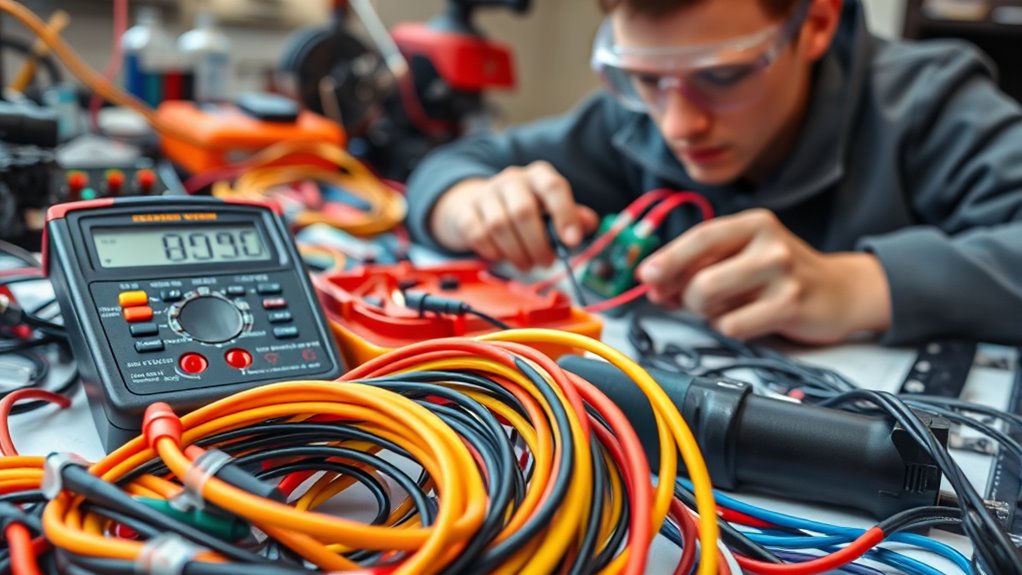Many beginners mistakenly believe all electrical circuits are interchangeable, but differences in voltage and current ratings make compatibility essential. Assuming higher voltage or more wires improves safety can lead to hazards like overheating. Overlooking grounding, wrong components, or incorrect wire sizes risks shocks, fires, and equipment damage. Replacing circuit breakers with fuses isn’t always safe without proper verification. Clarifying these misconceptions helps you build safer, reliable systems—whether you’re just starting out or want to improve your skills further.
Key Takeaways
- Many beginners assume all electrical components and circuits are interchangeable, risking damage and safety hazards if specifications aren’t matched.
- Confusing voltage with amperage can lead to improper device use and dangerous electrical shocks or fires.
- Proper wiring size and ratings are crucial; using incorrect gauge or length increases overheating and fire risks.
- Neglecting grounding and earthing compromises safety, potentially causing shocks, equipment damage, and code violations.
- DIY electrical repairs without proper knowledge, tools, or adherence to standards can result in serious accidents and equipment failure.
Believing All Circuits Are the Same and Can Be Interchanged
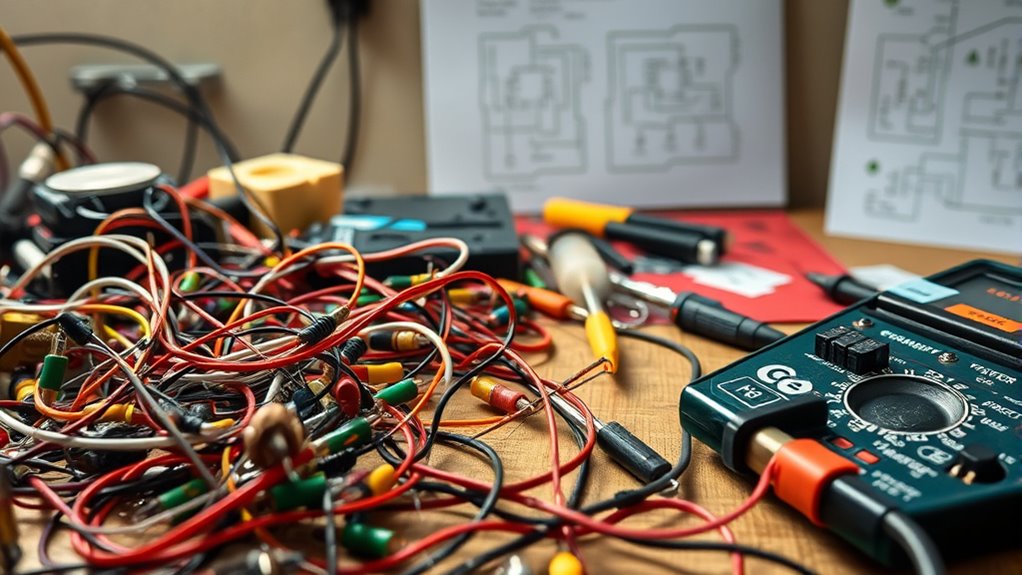
Many beginners assume that all electrical circuits are identical and can be swapped without issues. However, circuit compatibility varies greatly depending on the device and application. Not all circuits have the same voltage, current capacity, or wiring requirements. Attempting to interchange wiring without understanding these differences can lead to malfunctions or safety hazards. Wiring interchangeability depends on matching the correct connectors, wire gauges, and circuit types. For example, a circuit designed for low voltage might not handle higher power loads safely. Always check the circuit specifications before swapping components or wiring. Ignoring these differences can damage your devices or cause dangerous shorts. Proper knowledge of circuit compatibility is essential to ensure your electrical work is safe, effective, and reliable. Additionally, understanding the importance of circuit specifications can help prevent costly mistakes and ensure safety.
Assuming More Voltage Is Always Better for Powering Devices
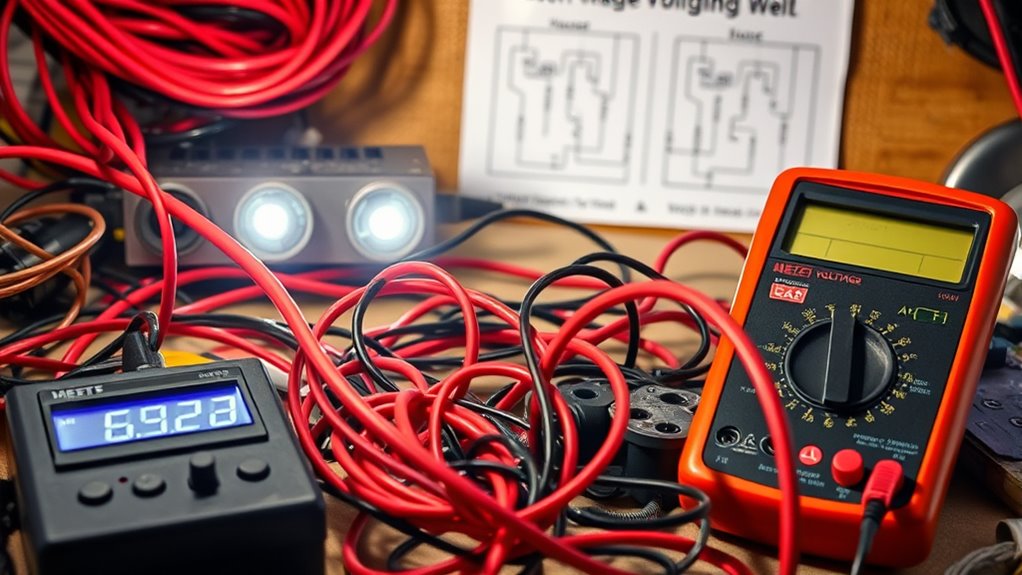
Assuming that more voltage automatically means better performance can be dangerous and counterproductive. Many fall for voltage myths, thinking higher voltage always improves device function. However, circuits differ in their voltage requirements and tolerances. Using too much voltage can damage components or reduce lifespan. Always check the device’s specified voltage; exceeding it risks overheating and failure. Additionally, understanding the voltage requirements of your specific devices ensures you maintain optimal and safe operation.
Thinking That Using More Wires Improves Electrical Safety
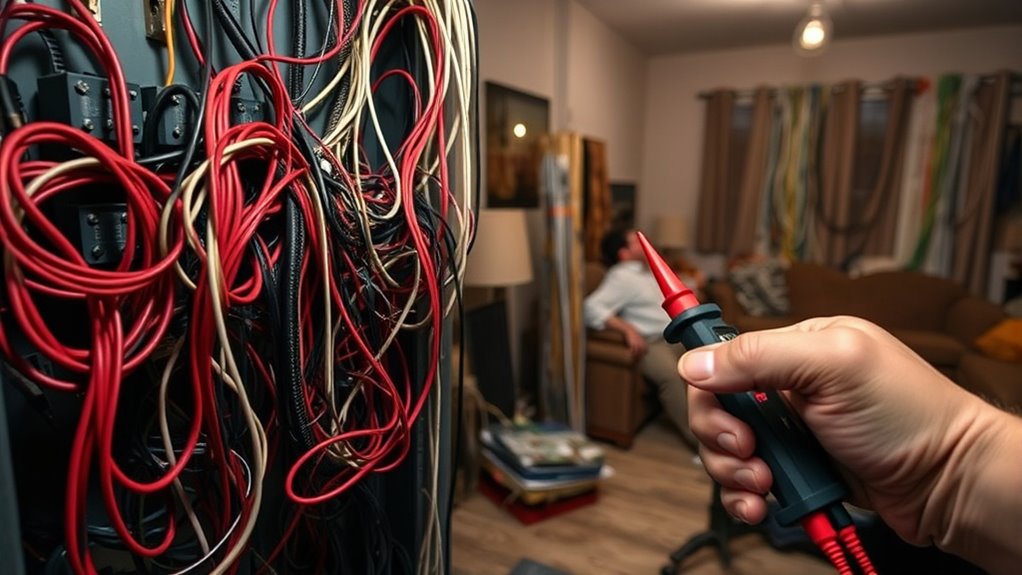
Adding more wires to a circuit might seem like a way to boost safety, but it can actually create new risks. Longer wire length increases resistance, which can lead to overheating and potential fires. Using extra wires unnecessarily can also cause confusion, especially if wire color coding isn’t clear, making troubleshooting harder and increasing the chance of incorrect connections. More wires don’t improve safety if they are not properly rated for the current or if they’re installed poorly. Instead of adding wires, focus on proper wiring practices, such as using the correct gauge, maintaining neat connections, and following color codes for hot, neutral, and ground. Proper wiring techniques ensure the safety and reliability of your electrical system. Remember, quality and proper installation matter more than simply increasing the amount of wiring in your circuit.
Overlooking the Importance of Proper Grounding and Earthing
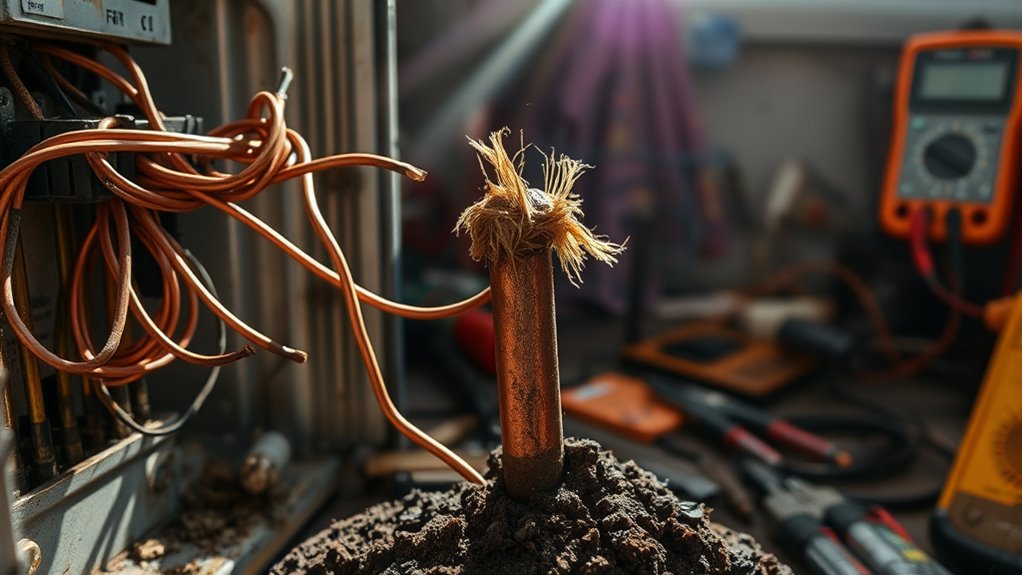
If you overlook proper grounding and earthing, you risk electrical shocks and equipment damage. Grounding helps prevent shock hazards, while correct earthing keeps everything safe during faults. Neglecting these steps can lead to costly damage and dangerous situations. Proper grounding and earthing are essential components of electrical safety that protect your family and ensure the longevity of your electrical system.
Grounding Prevents Shock Risks
Proper grounding is essential for preventing electrical shock hazards. When your electrical system is properly grounded, excess current safely flows into the earth instead of passing through your body. This grounding safety feature minimizes the risk of shock, especially if a device’s insulation fails or a wire becomes loose. By ensuring that appliances and outlets are correctly grounded, you create a reliable path for stray electricity, which is vital for shock prevention. Without proper grounding, you leave yourself vulnerable to dangerous electrical shocks that could result in injury or even death. Always verify that your electrical system includes proper grounding measures. Grounding safety is a critical aspect of electrical system design that should never be overlooked. Prioritizing grounding safety isn’t just about compliance; it’s about protecting yourself and your loved ones from potentially life-threatening electrical shock risks.
Proper Earthing Ensures Safety
While grounding your electrical system helps prevent shocks, guaranteeing proper earthing adds an extra layer of safety. The grounding importance can’t be overstated, as it directs stray current safely into the ground, reducing the risk of electrocution or fire. Proper earthing ensures that all electrical equipment is connected to a reliable earth connection, which stabilizes voltage levels. This minimizes the chance of electrical faults causing harm or damage. When earthing safety is prioritized, it helps protect both people and property from unexpected electrical issues. It’s essential to use the right grounding materials and follow local standards to maintain effective earthing. Remember, neglecting proper earthing can lead to dangerous situations, making it a vital part of any electrical installation for beginners.
Neglect Leads to Damage
Neglecting proper grounding and earthing can cause serious damage to your electrical system and appliances. Without correct grounding, circuit overloads can occur more easily, risking overheating and potential fires. Wiring misconfigurations become more dangerous because ungrounded systems don’t provide a safe path for excess current, increasing the chance of electrical shocks or equipment failure. When grounding isn’t properly established, surges from lightning or power fluctuations can flow unchecked, damaging sensitive electronics. Over time, this neglect weakens your system’s integrity, leading to costly repairs or replacements. Ensuring proper grounding and earthing acts as a safeguard, redirecting excess current safely into the earth. Proper grounding also enhances cognitive function, by preventing electrical interference that can disrupt electronic devices used in mental health practices such as meditation and mindfulness. Don’t overlook this crucial step—proper grounding prevents damage, improves safety, and enhances the longevity of your electrical setup.
Believing That Circuit Breakers Can Be Replaced With Fuses Without Issues

Many beginners assume that replacing a circuit breaker with a fuse is a simple swap that won’t cause any problems. However, fuse replacements aren’t always straightforward and require careful consideration of breaker compatibility. Not all fuses are suitable for replacing circuit breakers, especially if the fuse’s amperage or type doesn’t match the original breaker’s specifications. Using an incompatible fuse can lead to electrical hazards, including fires or equipment damage. Additionally, circuit breakers are designed to trip under specific conditions, providing reliable protection. Fuses, on the other hand, may not offer the same level of safety if improperly selected. Before attempting any fuse replacements, you should verify compatibility with your system to *guarantee* safe and effective operation. Understanding electrical components and their proper functions can help prevent accidents and ensure your system’s integrity.
Underestimating the Risks of DIY Wiring and Repairs
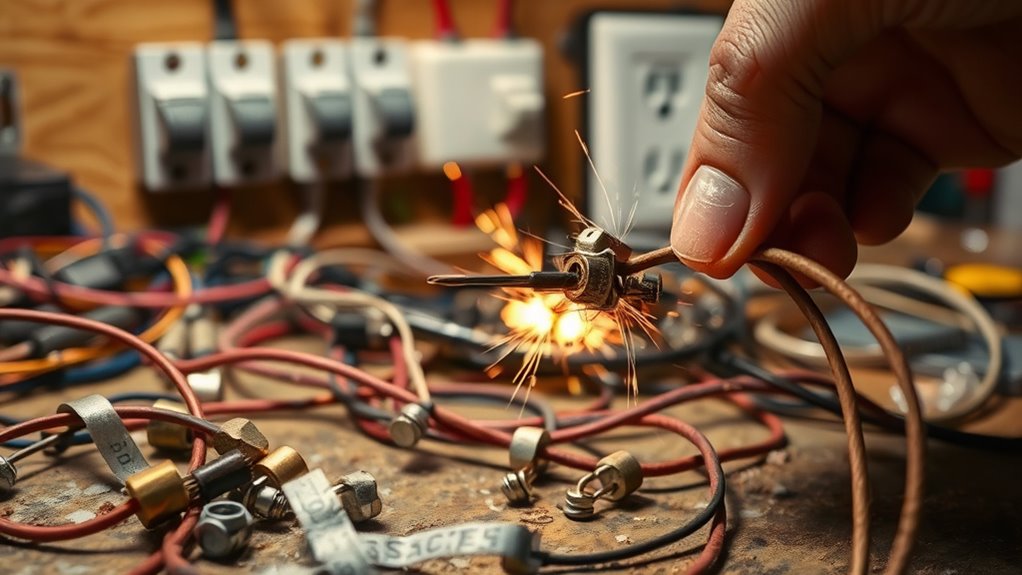
Have you fully considered the dangers of DIY wiring and repairs? Many people underestimate DIY hazards, thinking they can handle small fixes without professional help. This safety misconception can lead to serious accidents, including electrical shocks, fires, or damage to your home’s wiring system. Without proper knowledge and tools, you risk misjudging wiring connections, overloads, or grounding issues. Even minor mistakes can have big consequences, yet many beginners believe they’re safe enough to proceed. Remember, electricity is unpredictable and dangerous if not handled correctly. Don’t fall into the trap of thinking DIY repairs are simple or risk-free. Protect yourself and your home by recognizing that electrical work is best left to licensed professionals. Your safety depends on it. Additionally, understanding cybersecurity risks related to electrical devices can prevent potential vulnerabilities that could be exploited remotely.
Confusing Amperage With Voltage and Their Impact on Safety
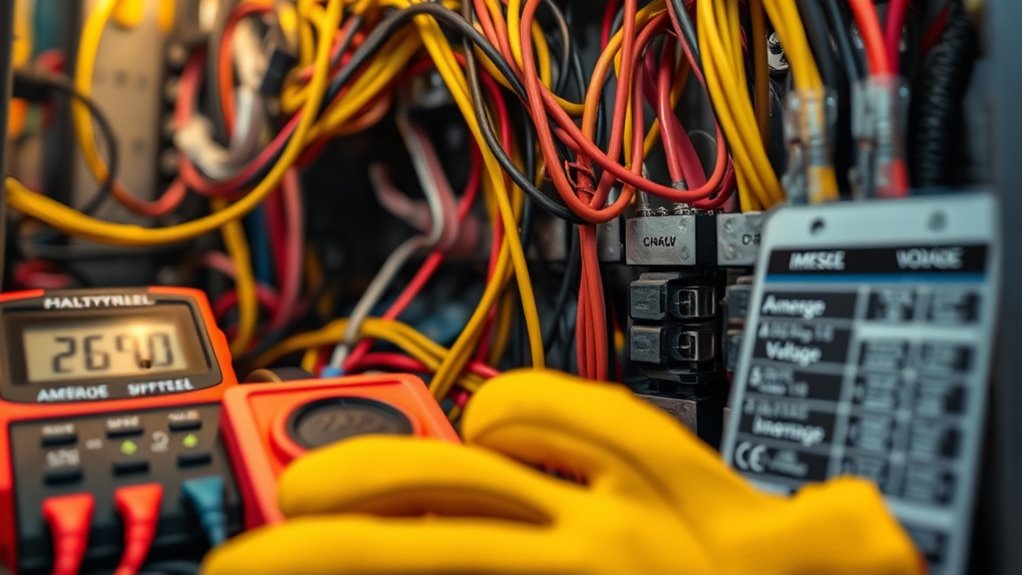
Understanding the difference between amperage and voltage is essential because confusing these two can lead to serious safety mistakes. Amperage comprehension helps you realize that high current can cause fires or burns, even if the voltage seems low. Conversely, high voltage safety reminds you that a dangerous electrical potential exists, which can cause shocks or electrocution. Many beginners mistakenly believe that voltage and amperage are interchangeable, but they serve different purposes in an electrical system. Voltage is the force that pushes electrical current, while amperage measures how much current flows. Misjudging this distinction can lead to improper wiring, faulty circuit protection, or unsafe handling of electrical devices. Additionally, understanding the flow of water in aquatic systems can provide a helpful analogy to grasp how electrical current moves through circuits. Always respect both amperage understanding and voltage safety to prevent accidents and ensure safe electrical practices.
Assuming That All Electrical Components Are Compatible Without Verification
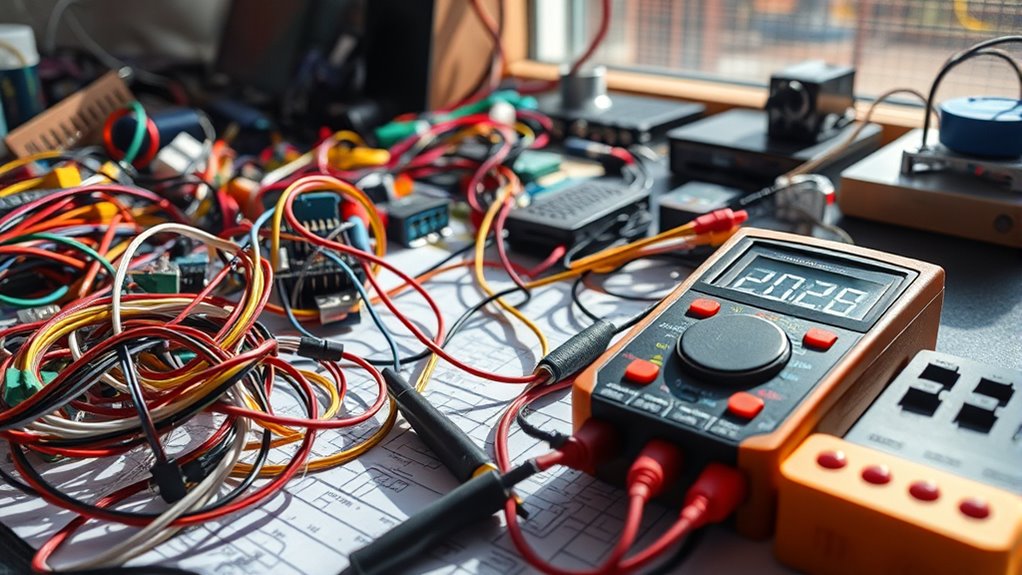
Assuming all electrical components are compatible without proper verification can lead to dangerous situations. Not all components are interchangeable; mismatched ratings may cause overheating, failure, or fire. Always check component compatibility before connecting parts. Circuit interchangeability isn’t guaranteed by appearance alone, so verify specifications like voltage, current, and ratings. Additionally, understanding emotional support can help when dealing with the stress of troubleshooting electrical issues. Ignoring these details risks damage or safety hazards. Proper verification ensures your project remains safe and functional, avoiding costly mistakes.
Ignoring the Significance of Correct Wire Sizes and Ratings

Ignoring the correct wire sizes and ratings can lead to overheating, risking damage and fires. It also compromises circuit safety and may cause components to fail. To stay compliant with standards, you need to match wire sizes properly to the load and application.
Prevents Overheating Risks
Choosing the wrong wire sizes or ratings can substantially increase the risk of overheating. When wires are undersized, they struggle to handle current flow, leading to excessive heat buildup. Proper thermal management involves selecting wires with appropriate ratings to prevent this issue. Insulation techniques also play a vital role in heat dissipation and safety. To guarantee ideal performance, consider this table:
| Wire Size Rating | Hazard Level | Recommended Action |
|---|---|---|
| Undersized | High risk of overheating | Upgrade to correct size |
| Proper sizing | Low risk of overheating | Maintain current standards |
| Oversized | Minimal risk | Use as needed for safety |
Always match wire ratings to your circuit’s load to avoid overheating, guaranteeing safety and longevity of your electrical system.
Ensures Circuit Safety
Proper circuit safety depends on more than just avoiding overloads; it also requires using the correct wire sizes and ratings. Choosing the right wire ensures that insulation integrity is maintained under load, preventing potential overheating or fires. Proper circuit labeling is essential, so you know which wires carry which current and can perform inspections or repairs safely. Using wires with appropriate ratings reduces the risk of insulation failure, which can compromise safety. Always verify that the wire gauge matches the circuit’s current requirements and that insulation quality is intact. Neglecting these details can lead to shorts, fires, or electrical failures. By paying attention to wire sizes, ratings, circuit labeling, and insulation integrity, you create a safer electrical system that minimizes hazards.
Complies With Standards
Ensuring your electrical system meets established standards helps prevent hazards and promotes reliability. When your system complies, it includes proper ground fault protection, which quickly disconnects power if a ground fault occurs, reducing shock risks. Additionally, circuit isolation is maintained to prevent unintended connections that could cause overloads or short circuits. By following standards, you guarantee that wiring, breakers, and devices are correctly rated and installed, reducing the chance of electrical failure. This helps you avoid dangerous situations like electrical fires or shocks, safeguarding both people and property. Remember, adhering to standards isn’t just about compliance—it’s about creating a safe, dependable electrical setup that performs reliably over time. Proper standards implementation forms the foundation for a secure and efficient electrical system.
Thinking That Electrical Codes Are Optional or Only for Professionals

Many beginners mistakenly believe that electrical codes are just suggestions or only apply to licensed professionals. In reality, following electrical licensing requirements and ensuring code compliance are essential for safety and legality. Ignoring these codes can lead to hazards, fines, or needing costly repairs later.
Consider these points:
- Electrical codes specify safe wiring practices everyone must follow.
- Proper electrical licensing ensures your work meets legal standards.
- Code compliance reduces the risk of electrical fires or shocks.
- Non-compliance can invalidate insurance and cause issues during home sales.
Thinking codes are optional puts you at risk of dangerous mistakes. Always respect electrical licensing rules and adhere to the standards for your safety and peace of mind.
Frequently Asked Questions
How Do I Properly Identify the Correct Wire Gauge for My Project?
To identify the correct wire gauge for your project, start with a circuit load analysis to determine how much current your device needs. Use this info to select the appropriate wire gauge; thicker gauges handle higher loads. Consult a wire gauge chart or electrical codes for guidance. Always double-check your calculations and guarantee your chosen wire can safely handle the circuit’s current, preventing overheating or hazards.
What Safety Precautions Should I Take Before Attempting DIY Electrical Work?
Before starting DIY electrical work, you should turn off the power at the breaker and test the circuit to make certain it’s dead. Check the insulation of wires to spot any damage, and use a voltage tester for added safety. Always wear insulated gloves and goggles, and work in a dry environment. Taking these precautions helps prevent electric shocks and guarantees your safety during electrical projects.
Why Is Grounding Essential for Electrical Safety?
Grounding importance can’t be overstated; it’s crucial for electrical safety because it provides a safe path for stray currents, preventing shocks and fires. Safety grounding helps protect you by directing excess electricity away from outlets and appliances. When you guarantee proper grounding, you reduce the risk of electric shock, equipment damage, and electrical fires. Always verify your grounding system’s integrity to keep yourself and your home safe during electrical work.
How Can I Determine if My Circuit Breaker Matches My Appliance’s Needs?
To determine if your circuit breaker matches your appliance’s needs, check the appliance’s power requirements and compare them to the breaker’s rating. Proper breaker selection ensures circuit compatibility, preventing overloads. Look at the amperage label on your appliance and confirm it matches the breaker’s capacity, usually marked on the breaker itself. If you’re unsure, consult an electrician to verify that your breaker is suitable for your appliance’s power demands.
When Should I Consult a Professional Electrician Instead of DIY?
You should consult a professional electrician whenever DIY pitfalls could lead to safety hazards or code violations, especially for complex tasks like wiring or panel upgrades. While DIY can save money initially, cost considerations include potential repairs from errors. If you’re unsure about proper grounding, circuit loads, or breaker matching, it’s safest to hire a pro. Protect yourself and your home by knowing when professional expertise is essential.
Conclusion
Understanding electrical basics might seem simple, but overlooking key details can lead to hazards or damage. Do you really want to risk a short circuit or fire just because you assumed all circuits are the same? By paying attention to proper wiring, grounding, and component compatibility, you keep yourself safe and your devices working smoothly. Isn’t investing a little time in learning these essentials worth avoiding costly mistakes later?
